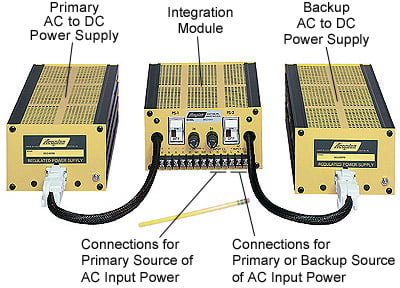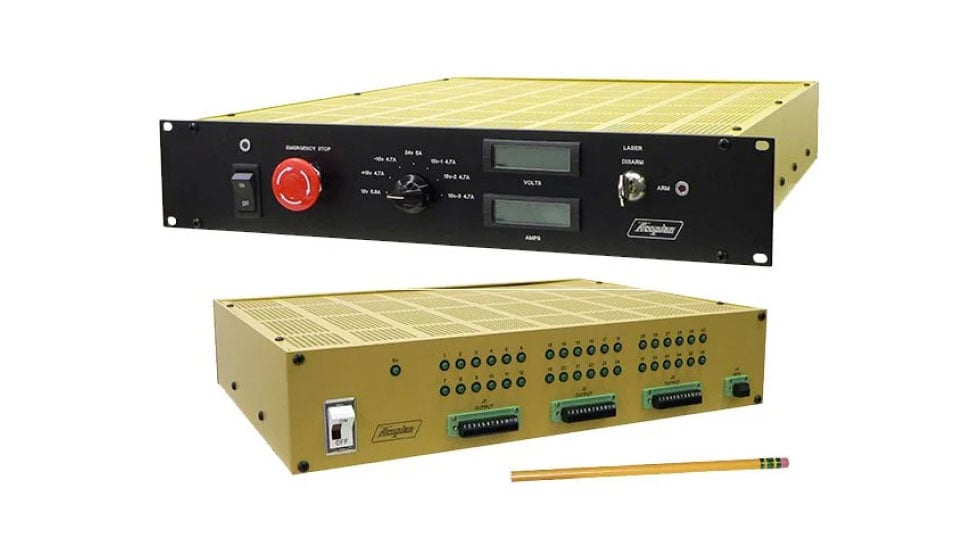AC-DC Redundant Power Supplies

Redundancy in a system is the practice of designing in duplicates of critical system components with the intention of increasing system reliability. Usually, these components are connected in parallel and function as a single unit, with one taking over if the other fails. This is exactly the method used in Acopian's redundant power supply systems. Two power supplies are connected in parallel through "auctioneering" diodes and operate as one power supply, with seamless power transfer if one power supply fails. These systems also have dual AC inputs and alarm outputs for increased reliability. Acopian redundant power supply systems feature hot-swappable power supplies with insulated quick release connectors and are thumbscrew mounted or pluggable (depending on model) for quick replacement. Acopian manufactures redundant power supplies and redundant power systems in both linear and switch mode designs. They are offered in the form of rack mount, wall mount or modular design. The rack and wall mount packages have built-in voltmeters for quick setup and monitoring. All units are designed with alarm outputs that can be used by the customer to annunciate the failure of a power supply in the redundant package.
Can I make my own redundant power system by connecting two power supplies in parallel?
While it is possible to connect two power supplies for redundant operation, there are many issues to take into account:
An isolation diode must be used in series with the output of each power supply, for two reasons - to avoid the possibility of the combined output being shorted by a shorted supply, and to prevent current from one supply flowing back into another and reverse biasing it (which could cause it to malfunction). However, the use of diodes introduces a significant voltage drop in the output voltage from the supply; for example, a 5 volt output might drop to only 4 volts. Using Schottky diodes can in some cases mitigate the diode drop, but it must still be considered. And keep in mind that the supply must be capable of providing a voltage equal to the sum of the voltage required across the load, the diode drop AND the drops in the wiring.
A typical power supply can compensate up to a volt or so of drops in the wiring, but may not be capable of compensating BOTH the wiring and the diode drops. And if you're using remote sensing to regulate the voltage across the load, you might not be able to solve this problem by simply stepping up to a supply with a higher nominal output voltage (for example, going from a 5 volt supply to a 6 volt supply), because then the sense lines of that supply would try to maintain a nominal 6 volts across the load! In summary, be sure to use a supply that can put out a voltage high enough to compensate both the diode and wiring drops under worst-case conditions (usually, low line and maximum load current), and also has the desired load voltage within its adjustment range.
Monitoring each power supply's output is also very important. Otherwise, you might not even know that one power supply is out until the other goes, and then it's too late - you're down! Voltmeters are helpful, of course, but they don't command your attention. An audible alarm can't be easily ignored. Include an undervoltage alarm circuit for each power supply, and use them to control an audible alarm, either built-in or remotely located where it will be heard.
Power supplies used in redundant applications should always be equipped with fast-acting overvoltage protection to assure that the output voltage can't go much higher than the nominal. Power supplies don't always go low when they fail; the voltage can instead go high - by 50% or more in some cases - and fry the load.
Replacing an inoperative power supply while the system remains in operation requires that each power supply have a separate AC input switch, so that the inoperative supply's wiring can be deactivated without affecting the other(s). Similarly, it must be possible to disconnect the inoperative supply and connect the replacement quickly and easily, so insulated connectors that can be easily pulled apart should be used in the wiring to each supply. And the supplies should be mounted in such a way that they can be easily and quickly removed and replaced. One way of doing this is to use thumbscrews for mounting; this also eliminates the need for tools.
Comprehensively addressing all of these considerations can be a lot of work. However, you don't need to do it yourself! Acopian's standard Redundant Systems meet all of these requirements, and are available with outputs from 5 to 125 VDC and in a choice of mechanical configurations (rack mounting, wall mounting and modular systems that can be mounted on a DIN rail).
Why are there two AC inputs on my Acopian redundant power package?
Acopian redundant power packages come equipped with two AC inputs for increased reliability. Each power supply has a separate AC input, so you can use two AC circuits to feed the redundant system. Some customers have a UPS system, and feed the redundant power package with AC from the UPS system in one AC input, and a standard AC feed from the power distribution system into the other AC input. If you don't have two AC power feeds, simply tie the two AC inputs together and feed the redundant package from one AC supply.
What is N+1 Redundancy?
Acopian's low profile switched mode power supplies, when ordered with the "N" option, can be connected (up to four units) for an N+1 redundant output. N+1 redundancy means that there is one more power supply connected than the load actually requires, and that even with the loss of one power supply, the load will continue to function normally. For example, if a load requires 15A to operate properly, connect four (4) 5A power supplies in parallel. If one power supply fails, there will still be 15A available.
Linear Regulated Redundant Power Systems
- Rack or wall mount
- 15-425Watts
- 5-125VDC
- Hot-swappable power supplies
Switching Regulated Redundant Power Systems
- Rack or wall mount
- 12-1200 Watts
- 12-48VDC
- Hot-swappable power supplies
Switching Regulated Pluggable Redundant Power System
- 50-275 Watts
- 3.3-125VDC
- Hot-swappable pluggable power supplies
Linear Regulated Modular Redundant Power Systems
- 13-425 Watts
- 5-125VDC
- Hot-swappable power supplies
- DIN rail mountable
Switching Regulated Modular Redundant Power Systems
- 15-275 Watts
- 3.3-125VDC
- Hot-swappable power supplies
- DIN rail mountable
AC-DC Redundant Power Supply: N++1 Redundancy, Switching
450 -720 Watts modular, 450-720 Watts 1U rack or bench top
- Short circuit and overload protected
- Overvoltage protection
- Pluggable input/output terminal block
- Universal input (90-265VAC, 49-420HZ, 110-350VDC)
- Power factor correction (PFC)
- Internal EMI filter and RFI shielding
- Soft start
Typical applications
- Nuclear power plants
- Refineries
- Continuous process industries
- Aerospace
- Medical
- Traffic control
- Emergency notification systems
- AC-DC SINGLE OUTPUT POWER SUPPLIES
- AC-DC DUAL & TRIPLE OUTPUT POWER SUPPLIES
- AC-DC WIDE ADJUST OUTPUT POWER SUPPLIES
- DC-DC CONVERTERS
- HIGH VOLTAGE, AC-DC & DC-DC (0 - 30,000 volts)
- REDUNDANT SYSTEMS and N+1 POWER SUPPLIES
- POWER SYSTEMS (Online System Builder) Built to your requirements
- Linear Power Supplies
- Switching Power Supplies
- Unregulated Power Supplies
- 1U Power Supply Models
- 2U Power Supply Models
- Programmable Power Supplies
- Universal Input Power Supplies
- Constant Current Power Supplies
- Power Factor Correction Power Supplies
- DIN Rail Mountable Power Supplies
- Wall Mount Power Supplies
- Rack Mount Power Supplies
- UL508 Power Supplies
- NEMA 4X Enclosed Power Supplies

 Made In The USA
Made In The USA


